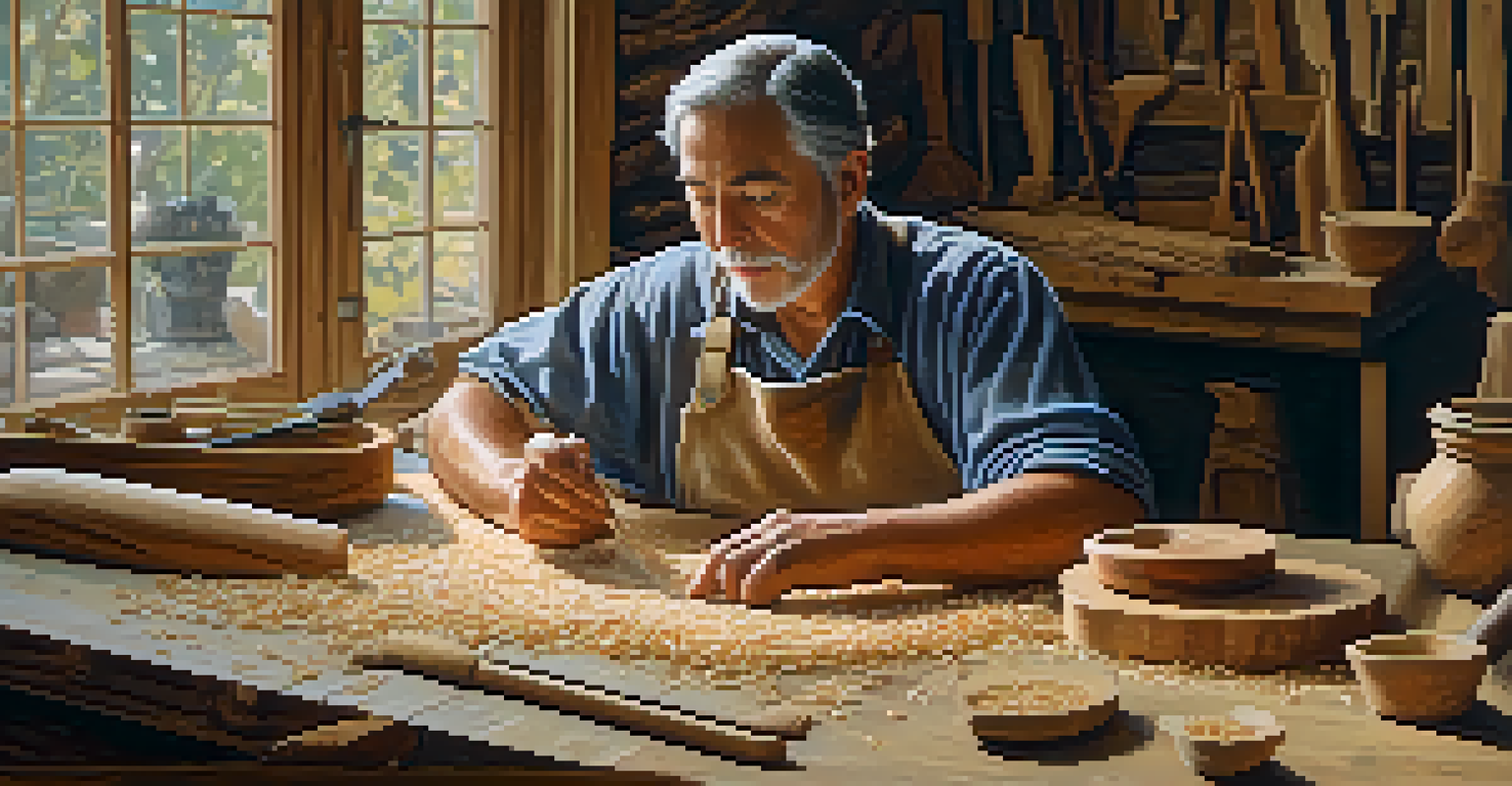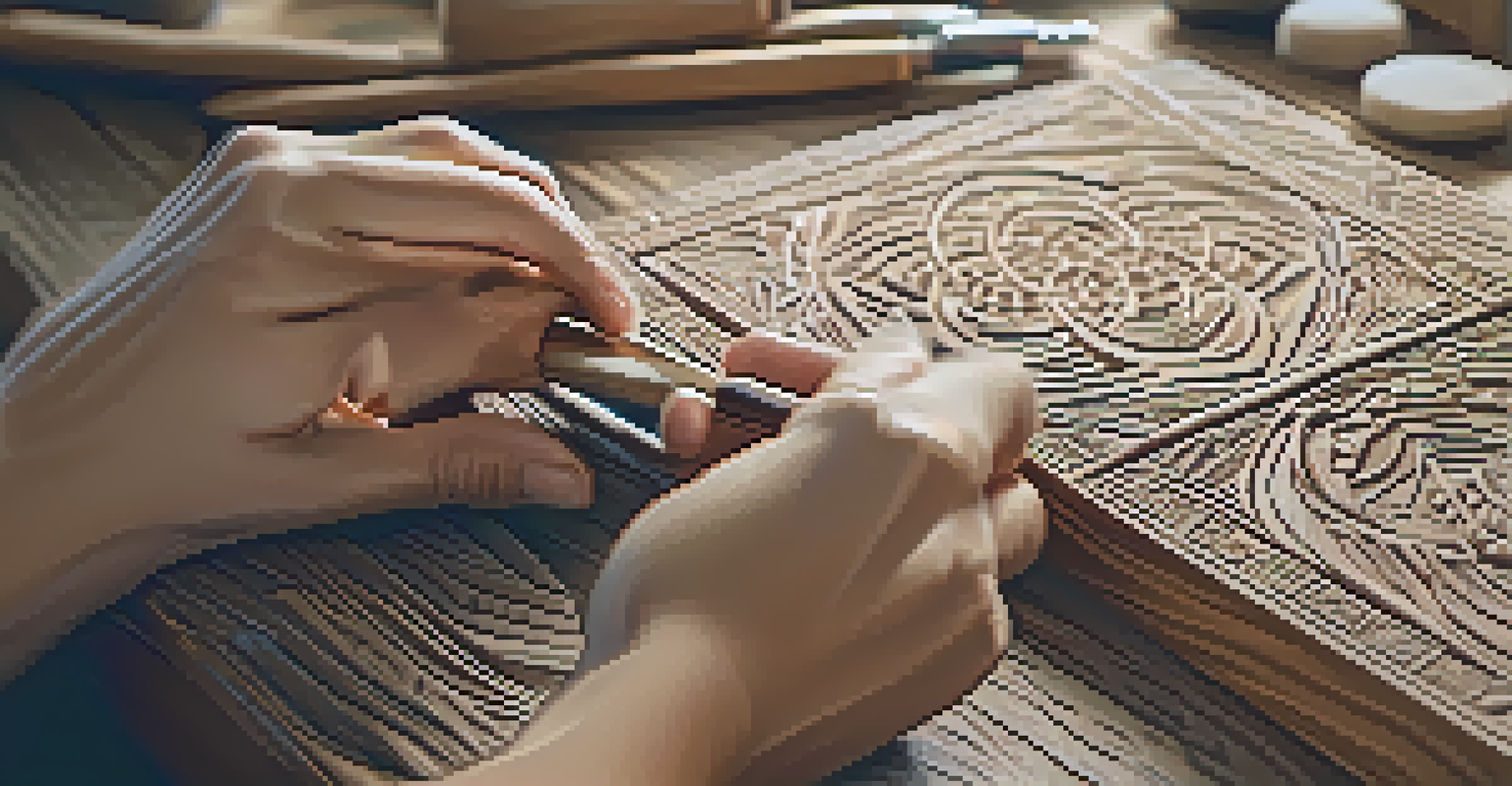Creating Art: Carving as a Form of Mindfulness Meditation

What is Mindfulness Meditation and Why It Matters?
Mindfulness meditation is the practice of being fully present in the moment. It encourages us to observe our thoughts and feelings without judgment, creating a space for clarity and calm. This practice can significantly reduce stress and enhance emotional well-being, making it a valuable tool in our fast-paced lives.
Mindfulness is a way of befriending ourselves and our experience.
When we engage in mindfulness, we train our minds to focus, much like a sculptor focusing on their block of stone. This ability to concentrate can lead to greater creativity and productivity in daily tasks. Essentially, mindfulness helps us reconnect with ourselves, fostering a deeper understanding of our emotions and thoughts.
Incorporating art into mindfulness practices, such as carving, adds a tactile and visual dimension. The physical act of shaping and carving material can ground us, enhancing our awareness of the present moment. This combination of art and mindfulness offers a unique pathway to emotional healing and personal growth.
The Therapeutic Benefits of Carving
Carving as an art form can be incredibly therapeutic. The repetitive motions involved in carving can have a meditative quality, allowing your mind to quiet and focus solely on the task at hand. This can help alleviate anxiety and promote a sense of peace, similar to how some people find solace in gardening or knitting.

Moreover, working with your hands can be a powerful way to express emotions that might be difficult to articulate verbally. Each cut and curve in the material can symbolize feelings and thoughts, creating a tangible representation of your inner world. This process not only provides an outlet for emotional expression but also fosters a sense of accomplishment.
Mindfulness Through Carving
Carving serves as a meditative practice that enhances emotional well-being and fosters a deeper awareness of thoughts and feelings.
As you carve, you may find that your worries begin to fade away. Much like how a sculptor sees the form within the stone, you might discover new insights about yourself. This reflective process can lead to personal revelations, enhancing your overall well-being.
Choosing the Right Materials for Carving
The choice of materials is crucial when it comes to carving. Beginners might start with softer woods like pine or basswood, which are easier to carve and forgiving for those learning the craft. As you gain more experience, you can explore harder woods or even stone, each offering unique challenges and benefits.
The creation of something new is not accomplished by the intellect but by the play instinct acting from inner necessity.
Beyond wood, materials like soapstone or clay can serve as excellent mediums for mindfulness carving. These materials allow you to experiment with different techniques and styles, encouraging creativity and self-expression. Choosing the right material can also influence your mood and focus during the carving process.
Ultimately, the material you choose should resonate with you personally. Whether it's the warmth of wood or the coolness of stone, finding a medium that you connect with can enhance your mindfulness experience. This connection to your materials can deepen your engagement and make the act of carving even more fulfilling.
Setting Up Your Carving Space for Mindfulness
Creating a dedicated carving space can enhance your mindfulness practice. Choose a quiet area where you can focus without distractions, allowing you to immerse yourself fully in the act of carving. A well-organized workspace with all your tools at hand can also help you feel more prepared and engaged.
Consider adding elements to your space that promote relaxation, such as soft lighting, calming music, or even scents that you find soothing. These elements can create an atmosphere conducive to mindfulness, helping you to settle into the moment more easily. Incorporating a comfortable chair or standing desk can also make a difference in how you feel while carving.
Choosing the Right Materials
Selecting materials that resonate personally can enhance the mindfulness experience, making the act of carving more fulfilling and engaging.
Finally, remember to keep your space clean and clutter-free. A tidy environment fosters a clearer mind, making it easier to focus on your carving. By setting up a mindful space, you’re not just preparing to create art; you’re also preparing your mind for a meditative journey.
Techniques to Enhance Mindfulness While Carving
To fully experience mindfulness while carving, try techniques that connect you with the present moment. One effective approach is to focus on your breath. Before you begin carving, take a few deep breaths, allowing yourself to center your thoughts and clear your mind. This simple practice can transform your carving session into a meditative experience.
As you carve, engage your senses. Pay attention to the texture of the material, the sound of the tools, and the rhythm of your movements. By immersing yourself in these sensory experiences, you can cultivate a deeper connection to the act of carving, making it more than just a task but a mindful practice.
Lastly, embrace the imperfections in your carving. Just as in life, mistakes can lead to unexpected beauty and growth. Allow yourself to be present with whatever emerges, letting go of the need for perfection. This acceptance fosters a sense of peace and can enhance your overall mindfulness experience.
Carving as a Community Activity for Mindfulness
Carving can also be a wonderful community activity, bringing people together and enhancing mindfulness in a social setting. Joining a carving group or workshop allows you to share experiences, exchange ideas, and learn from one another. This communal aspect can foster a sense of belonging and support that enhances your mindfulness practice.
Engaging with others while carving can lead to meaningful conversations and connections. As you share stories and techniques, you create a space for collective mindfulness, where everyone is present and engaged. This social interaction adds an enriching layer to the solitary act of carving.
Community Enhances Mindfulness
Participating in group carving activities fosters connections and shared experiences, enriching the mindfulness practice through social interaction.
Moreover, participating in group carving sessions can introduce you to new perspectives and inspirations. You might discover techniques you hadn’t considered or themes that resonate with others, broadening your artistic horizons. This collaboration can deepen your mindfulness practice and make carving even more fulfilling.
Conclusion: Embracing Carving as a Mindful Practice
In conclusion, carving is not just an art form; it is a pathway to mindfulness and self-discovery. By engaging in this practice, you can cultivate a deeper awareness of your thoughts and emotions, transforming your carving sessions into powerful moments of reflection. The benefits extend beyond the art itself, contributing to your overall mental and emotional well-being.
As you explore carving, remember that the journey is just as important as the finished piece. Each stroke of the tool, each moment of focus, brings you closer to understanding yourself and the world around you. Embrace the process, and allow carving to be a source of joy and tranquility in your life.

So, gather your materials, find your space, and let your creativity flow. With every carve, you’re not just creating art; you’re carving out moments of mindfulness that can enrich your life in countless ways.